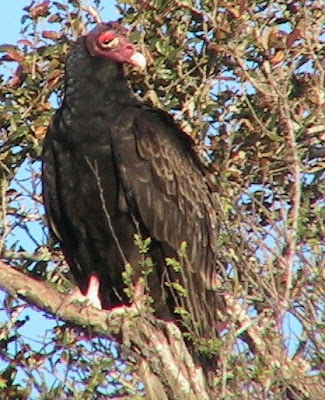

Jeff Mohamed blogs about birds and other wildlife in the Houston area - and occasionally farther afield.




 Killdeer
Killdeer
The Cooper's Hawk was a new year bird, as was this Northern Flicker.


Blue Jay
There has often been competition between birds of the same species, too. One Yellow-rumped Warbler is guarding his/her territory very fiercely and there have been numerous tussles between Pine Warblers and between Orange-crowned Warblers.
This Ruby-crowned Kinglet was shocked to discover that its preferred suet feeder had fallen to the ground but, when I rehung the feeder on another branch, he/she found it within seconds.
One of our male House Finches seems to be having trouble flying and we're hoping that it isn't anything serious. It's a little worrying that he let me get within two feet of him before flying off though.



 American Pipit
American Pipit There were groups of Black-bellied Whistling Ducks everywhere.

They and a couple of Little Blue Herons seemed totally unconcerned by our presence.

The trees near the lake were hopping with smaller birds: Red-bellied Woodpeckers, Blue-gray Gnatcatchers, Pine and Orange-crowned Warblers, Ruby-crowned Kinglets, Eastern Bluebirds and Tufted Titmice.
I couldn't get a good photo of an Eastern Bluebird ...
... and the Tufted Titmice were almost equally skittish.
Overall, Brazos Bend was very productive for birds. I saw 39 species, of which 12 were new for the year: Black-bellied Whistling Duck, Blue- and Green-winged Teal, Common Moorhen, Tricolored and Little Blue Heron, White Ibis, Red-shouldered Hawk, Tufted Titmouse, Carolina Wren, Blue-gray Gnatcatcher and Eastern Bluebird. Outside the park I saw two other new birds. Rock Dove/Pigeon and White-tiled Kites. This took my year list to 80 species, which is not bad considering how little birding I've done to date.


Gray Catbird (on Galveston)
So a very pleasant few minutes of birding, and three more species for my 2009 list. I wonder if any new birds will appear tomorrow.

Sandhill Cranes in the distance
I drove on to work via Paul Rushing Park and Longenbaugh Road, two other sites on the Katy prairie.
Paul Rushing had mainly expected birds: Savannah Sparrows, Killdeer, Horned and Horned Larks. However, I also spotted a Marbled Godwit and I was thrilled to see a Wilson's Snipe. I'd only seen a Snipe once before, ten years ago in Martinez, California.
Wilson's Snipe
Longenbaugh was quiet, except for more Savannah Sparrows. (These are the only sparrows I've seen in numbers this winter.) As usual, American Kestrels lined the road.
 American Kestrel
American Kestrel
The lone Pyrrhuloxia was at the Bear Creek bridge, accompanied by yet more Savannah Sparrows, a Winter Wren and a Brewer's Blackbird.

Brewer's Blackbird
At the college, the soccer fields were as busy as usual with flocks of Savannah Sparrows, American Pipits, Brown-headed Cowbirds, Red-winged Blackbirds and European Starlings. A White-throated Sparrow, an American Robin and a pair of Double-crested Cormorants moved my 2009 list to 60 species.



Nutmeg Mannikin in our yard
A little further afield, Dee and I made several very enjoyable birding trips to other Upper Texas Coast wildlife sites. Of these, the most exciting by far was a weekend in the Anahuac/High Island area in early May, during spring migration.

The rookery at High Island in May
The birding highlight of the late summer was supposed to be several days at Surfside with my daughter, her partner and our first grandchild. Although Hurricane Ike intervened to cut short the trip, we still got to do some good birdwatching at Brazoria, Surfside and Bolivar. (Unfortunately, several of our favorite birding sites were devastated by Ike and will take a very long time to recover.)

Black-bellied Plover on Surfside beach
Several business and family-related trips outside Texas were less productive for birds. A few days in London and Cambridge in March turned up plenty of birds but later trips to Mexico City and New Orleans were largely bird-free.

Tufted Duck in London
A day spent in the Denver area during the summer was also disappointing for birds, although the scenery certainly made the day worthwhile.

Swainson's Hawk in Denver

Roxborough Park near Denver
The highlight of the year was definitely our December trip to Marathon and Big Bend National Park. Birding was excellent at both places and the park scenery was absolutely breathtaking.

Chisos Basin in Big Bend
 Canyon Towhee in Big Bend
Canyon Towhee in Big Bend
My US species total for the year was 245, much higher than I managed in any previous year. I also added a dozen species to my US/Canada life list, which now stands at 421.
Other Sightings
Alligator at Brazos Bend State Park
 Coyote at Brazoria NWR
Coyote at Brazoria NWR
 Osprey
Osprey
 Northern Shoveler
Northern Shoveler Snowy Egret (left) and Tricolored Heron
Snowy Egret (left) and Tricolored Heron
Northern Harriers seemed to be everywhere but never close enough to photograph. The only shot I got was this one of a Harrier scaring up a couple of Blue-winged Teal.

So Brazoria may have suffered badly from Ike but we still had a very enjoyable visit. We ended up with a list of 43 species.